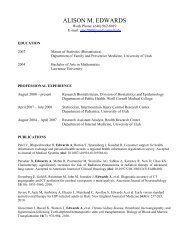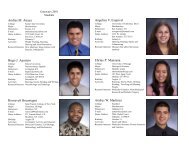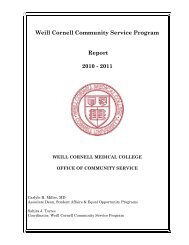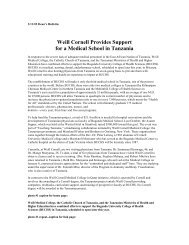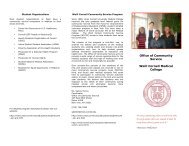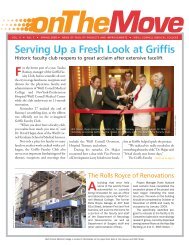Weillcornellmedicine - Weill Medical College - Cornell University
Weillcornellmedicine - Weill Medical College - Cornell University
Weillcornellmedicine - Weill Medical College - Cornell University
You also want an ePaper? Increase the reach of your titles
YUMPU automatically turns print PDFs into web optimized ePapers that Google loves.
<strong>Weill</strong> <strong>Cornell</strong>’s fall elective begins with two weeks in the emergency department at NewYork-<br />
Presbyterian Hospital/<strong>Weill</strong> <strong>Cornell</strong> <strong>Medical</strong> Center; then the focus shifts to wilderness medicine. Students<br />
spend a week in the city—attending lectures and taking field trips to the Bronx Zoo and New York<br />
Botanical Garden—before driving five hours north to Camp Dudley, a picturesque collection of log cabins<br />
overlooking Lake Champlain that’s the oldest boys’ camp in America. The students, mostly fourth-years<br />
from medical schools around the country, get an intense immersion—covering such topics as heat exhaustion,<br />
frostbite, dehydration, insect bites, burns, animal attacks, poisonous plants, fractures, dislocations,<br />
and lightning strikes. “You’re thinking outside the box—that’s the most important thing,” says Lemery, an<br />
assistant professor of medicine who attended Dudley as a child. “We’ve become more subspecialized in<br />
medicine and more reliant on technology, but you don’t want to abandon the skills of being a doctor.”<br />
Students participate in practical exercises (known as “scenarios”) by day and have fireside lessons each<br />
evening, on topics from identifying medicinal plants to removing a ring from a swollen finger. (In addition<br />
to their time at Dudley, this year’s group went on a three-night canoe-camping trip and hiked 3,352-foot<br />
Ampersand Mountain in a punishing rainstorm; the spring elective includes a western trip, most recently<br />
to Arizona.) They also learn survival techniques, like navigating with a compass and obtaining potable<br />
water. “Most of the time when we have students from the city and we have a scenario of a patient with a<br />
sprained or broken ankle, we ask, ‘What do you want to do now?’” Gaudio says. “They may say they want<br />
to call in a helicopter to evacuate the patient. But that might be logistically impossible—not having a landing<br />
field, not meriting that kind of resource, not having a cell phone. Sometimes they don’t know what it<br />
takes to rescue someone. An evacuation might take hours or days, and they have to be able to take care of<br />
the patient, keeping him warm, hydrated, nourished. So we give them an appreciation of that.”<br />
Students swap being “doctor of the day,” responsible for leading the team during the scenarios—which<br />
range from the snakebite incident to a trio of ankle injuries (incurred during an attempt to retrieve a<br />
Frisbee) to altitude sickness and hypothermia while climbing Ampersand. (As Santos recalls of Jessica Hu,<br />
To the rescue: Students<br />
Lindsay Cammarata, Cynthia<br />
Santos, and Kelly Grabbe treat<br />
McStay. Below: Professor Jay<br />
Lemery gives students feedback<br />
on their performance.<br />
WINTER 2008/09 27<br />
BETH SAULNIER




